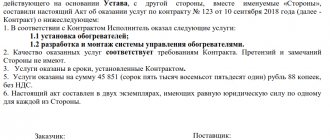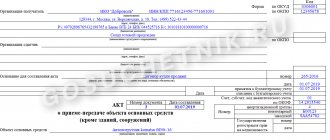Form KS-14 is a standard unified act that records that any construction project is completely completed and ready for operation. It is somewhat reminiscent of KS-11, but at the same time it has one distinctive feature: when drawing up the KS-11 act, as a rule, the customer and contractor are indicated, and when filling out KS-14, the acceptance committee, which includes representatives of supervisory authorities, is also included.
When drawing up the KS-14 form, the compliance of the construction site being put into operation is taken into account not only with the project, but also with building codes, how the communications being put into operation work, etc. On the basis of this document, the controlling government agencies decide whether it is possible to give permission to put this construction project into operation.
- Form and sample
- Free download
- Online viewing
- Expert tested
FILES
Hat KS-14
The first part of the KS-14 act includes the following information:
- date and number of drawing up the acceptance certificate of the completed construction project by the acceptance committee;
- name of the contractor organization according to the constituent documents indicating the OKPO code (from the registration papers of the organization);
- address of the construction site being accepted (city, street, house/building);
- the enterprise that appointed the commission for acceptance of the construction project;
- date and number of the administrative document (order) approved by the acceptance committee.
How to draw up a deed
Form
The number of copies of the act must correspond to the number of commission participants. All copies are signed by all members of the commission and have equal legal force.
The actual cost of work for the period of acceptance of the object is entered into the acceptance certificate. The act is accompanied by several documents in accordance with current legislation and building codes.
To draw up the act, a unified form is used, approved by Goskomstat Resolution No. 71a of October 30, 1997, and which is included in the list of unified forms adopted by Goskomstat 11.11. 1999 No. 100.
Although, starting from 2013, each organization has the right to develop and use its own form. But all experts agree that a unified form is most preferable.
Structure
The act contains the following information:
- serial number and date of compilation;
- name of the contractor and his details;
- full address of the location of the received object;
- the name of the enterprise that appointed the commission, as well as details of the order appointing the commission, indicating all its members;
- characteristics of the construction project, drawn up in the form of a table, taking into account its intended purpose, indicating the cost of each item;
- the cost of all work;
- conclusions and decisions of the commission;
The act is signed by each member of the commission and its chairman.
Instructions for filling
KS-14 you can here.
Strainca 1
On the first page of the form, basic information about the contractor, that is, the performer, the construction site and the duration of the work is entered:
- At the top of the page, the General Director’s visa “I approve” is placed, indicating the date of visa, with the signature and its transcript.
- Next is the act number, according to the numbering in this construction company.
- Details are entered: OKUD and OKPO code.
- Full name of the contractor according to the information in the constituent documentation. For example, you can shorten it a little: Stroytechnoservice LLC.
- The date for signing the act is set.
- The code for the type of operation, site, object and developer is entered.
- The full address of the object according to its passport is indicated: locality, region, street, number.
- Next, you need to enter the organization that appointed the acceptance commission and the details of the order for its creation.
- It is indicated who gave permission for construction, for example, the Department of Architecture and Urban Planning.
- The participants in the construction work are presented.
- The design organization that carried out the estimate work, as well as the organization that approved the estimate, are included.
- The year and month of the beginning and end of work at the site are indicated.
Page 2
Contains information about the characteristics of the object. Filled out in table form. The page contains several tables; you need to select the one you need from the following:
- Option 1. To be filled out for all objects except residential buildings, namely for industrial and commercial objects, warehouses. Information about productivity, power and other indicators is recorded. You must specify the unit of measurement and values. Design and final values are entered.
- Option 2. Residential premises, including commercial premises on the lower floors. You need to enter information for each apartment, floor and area. The following indicators are reflected: total area of the object;
- number of floors;
- the total volume of construction with a separate indicator for the underground part;
- the total area of all built-in and attached premises;
- number of apartments;
- total and residential area of each apartment;
- information for each category of apartments: one-, two-, three- and four-room apartments.
Sample of filling out form KS-14
Filling out data in KS-14
The following are the conditions for signing the act, namely:
Column 1. The full name of the construction project on which the contractor worked, indicating its address (city, street, house/building), is entered here.
Column 2. This includes the name of the government agency that issued the construction permit.
Column 3. This line contains information about subcontractors, that is, companies that also took part in construction work. If there are none, then this line can be skipped.
Column 4. Here you must enter the full name of the company - the general designer who developed the design and estimate documentation for the construction of this completed facility, indicating its address. Also, if any, other organizations that participated in the development of this documentation. If there are no such organizations, it should be noted that all design and estimate documentation was created entirely by one company.
Column 5. Provides a link to the document on the basis of which the initial design data was issued.
Column 6. This line includes information about the company that approved the design and estimate organization (as a rule, this is the construction customer, but sometimes an investor or other interested structure), as well as the approval date and document number.
Column 7. The period of construction and installation work is entered in these cells, indicating clear dates for the start and end of construction (month and year only).
Design features
Acts of form KS 11 and 14 are intended for the final acceptance of the object. They are not filled in during phased delivery of work. A completed construction project is considered accepted if these acts are signed (not specifically in this form).
Moreover, they are the basis
For:
- registration of commissioning of the facility (Article 55, Town Planning Code of the Russian Federation);
- acceptance of expenses in tax accounting (Article 252, Tax Code of the Russian Federation);
- reflection of a business transaction (Article 9, Law No. 402-FZ);
- acceptance of fixed assets for registration (Goskomstat of the Russian Federation, Resolution No. 71a, October 30, 1997).
Regarding documents such as KS-2 and KS-3
, then they are formalized for stage-by-stage delivery of work, if such delivery is provided for in the contract agreement. In addition, these forms are also used when subcontractors are involved in the construction of a facility for certain types of work. And without these intermediate forms, it is also impossible to recognize expenses in accounting and confirm the actual cost of the accepted object for which construction has been completed.
The commissioning of construction projects is described in the following video:
Now the pace of construction is constantly increasing, and this is not surprising, given that the planet’s population is increasing every year. This area of business is attracting more and more entrepreneurs and firms. However, it is impossible to simply erect buildings on unpurchased land.
In most cases, many building regulations must be followed and various activities must be coordinated. Permits, certificates, and inspections are required to perform certain actions. And, of course, one of the main points in such activities is design documentation. Documents and various acts indicate and regulate the relationship between the contractor and the company, and then between the company and the state.
Project documentation is a whole complex of architectural, functional-technological, engineering, structural documented solutions for construction and major repairs. Almost no building can be built without such a package of papers. And not the last places here are occupied by KS-11 and KS-14 - special acts. Many people confuse these papers, because their interpretation is really similar. However, they are different, and very much so. And every company and employees should know about all these points in advance, so as not to suffer later during audits and inspections. But before moving on to the acts of acceptance of construction projects, you need to understand some points related to previous events and the construction itself.
Filling out the table on the second page
The eighth column of the acceptance certificate includes two tables. The first of them contains six columns and applies to any construction projects, except residential buildings.
Column 1. Here you need to enter the name of the main indicator of the construction project (power, capacity, throughput, number of jobs, productivity, length, volume, etc.);
Column 2. The unit of measurement of the previous indicator is indicated here (cubic meters, square meters, etc.);
Columns 3-6. These columns contain information about how many total units of measurement for each previously specified indicator this object includes (according to the project and actually).
Table Option B is filled in only when the construction site is a residential building.
It has four columns, which also contain indicators and units of measurement (according to the project and actually).
Main differences in content
The act is a kind of acceptance document signed by the contractor and the customer of contract work upon completion of construction. But it is one of the main documents when issuing a permit for the competent authorities to issue a decision to put a property into operation (subclause 4, clause 3, article 55 of the Urban Planning Code of Russia).
Both acts - and, and - are the basis for accepting the object for accounting and reflecting the debt to the contractor (on their basis, the entry Dt 08 Kt 60 is made). At the same time, it confirms the fact of final acceptance by the customer of the completed contract work under the contract. KS 14, in addition to the above, will also testify to the fact that the facility was put into operation. Based on it, form OS-1a is drawn up and posting Dt 01 Kt 08 is made.
Read about drawing up the OS-1a act in the material
.
For the purpose of reflecting contract work in accounting, it will be sufficient to fill out the form. At the same time, if the participation of an acceptance committee is expected, for example, when state bodies or municipal bodies are represented in it (if a state-owned property is being rented out), it is no longer possible to do without drawing up an act.
Read more about the rules for drawing up acts related to construction in the article
.
How can a developer prepare documents to transfer a property to an investor? How to determine the date when a fixed asset was put into operation? Read about this in our article.
Question:
Upon completion of the construction of the plant, the general contractor provided us with a report in form KS-11. And who fills out the report in form KS-14 and why it is needed. What is the difference between these acts?
Answer:
Act KS 14 is one of the main documents when obtaining permission to put a facility into operation. It is drawn up if a construction permit has previously been obtained for construction work. After receiving permission to put the constructed facility into operation, the transfer of the facility is formalized by the KS-14 act.
Form KS-11 performs the function of a document of acceptance and transfer of a completed object with a description of all its characteristics. It is an acceptance document signed by the contractor and the customer of contract work upon completion of construction.
A capital construction project can be put into operation and be included in fixed assets only after receiving permission to put it into operation and completing forms KS-11 and KS-14 (Resolution of the Federal Antimonopoly Service of the Moscow District dated September 27, 2011 in case No. A41-25936/10 ).
Thus, the KS-11 act is necessary for the transfer of the object itself, and KS 14 will attest to the fact that the object was put into operation.
Filling out the third page
Column 9. Here you should refer to the application (i.e. indicate its number), which contains information about acts of acceptance of equipment installed at the facility;
Column 10. There should be a link to the application, which indicates acceptance certificates, certificates, etc. documents on communications included in the construction project.
Column 11. This small table contains information about all other work carried out on landscaping, improvement of roads, sidewalks, construction of sports, play, and utility buildings related to the main object of the completed construction (with a clear indication of the units of measurement, volume and deadline for completion of the work).
Columns 12-13. Here the numbers indicate the final cost of the construction project according to the design estimates, dividing the amount into the cost of construction and installation work performed and the cost of equipment, tools and inventory.
Column 14. Here is a reference to the number of the application, which contains a complete list of documentation that is an integral part of this act, in other words, has evidentiary weight in relation to it.
Column 15. Any additional conditions accompanying the fact of acceptance of the constructed building/structure are entered in this line.
Nuances of drafting
First of all, it is worth noting that there are no official explanations regarding the filling out of acts of the KS form.
But in practice, when filling them out, the following is taken into account:
:
- in the “Organization” column the name of the customer and his;
- in paragraph 3 of the header of the acts “Participated in construction” all subcontracting organizations are indicated - their names, legal addresses, bank details and types of work performed by them. The list of completed works is usually placed at the beginning, and the details and the name of the performer are next and next. If there were no such “assistants”, a dash is entered in the column;
- if there are appendices to acts, then their numbers are indicated in clause 9 and clause 10;
- if landscaping work was carried out (landscaping, road construction, etc.), they are indicated in clause 11 of the forms. If such work was not carried out, dashes are placed in the table;
- clause 12 indicates the cost of work according to the approved estimate. Moreover, all numbers here are indicated in words, except for kopecks;
- Clause 13 of the acts “Cost of accepted fixed assets” indicates the actual assessment of the object, which is reflected in account 08, including the contractor’s remuneration. All digital values are written in words.
Signatures of the parties
After the entire document is completed, the acceptance committee must make a decision that the construction project is completed in accordance with the project and meets all requirements for sanitary and epidemiological, environmental, fire, building rules, regulations and government standards and is ready for commissioning .
All members of the acceptance committee must put their signatures on this decision, with the obligatory decoding of their full names and positions.
Registration of the construction acceptance process
All construction work is subject to the norms of civil legislation of the Russian Federation, in particular, its Chapter 37, paragraph on construction contracts.
Based on Article 743 of the Civil Code of the Russian Federation, initially a
:
- technical documentation that defines the volume and nature of construction work;
- , in which the cost of all work is calculated.
Delivery of the object to the customer
, on which all work has been completed, is carried out in accordance with the norms of Article 753 of the Civil Code of the Russian Federation:
- acceptance by the customer of the work performed is documented in an act signed by both parties;
- if one of the parties does not consider it necessary to sign the act due to identified defects or for other reasons, a note about the refusal to sign must be made in the act;
- such a unilaterally signed act can be declared invalid only in court and provided that the reasons for refusing to certify the act are justified.
Form of this act
is not provided for in the Civil Code of the Russian Federation. Therefore, in practice, old forms are used, which until 2012 were recognized as unified:
- act form KS - 11;
- or an act of form KS - 14 - is used for objects for the delivery and acceptance of which the presence of a commission is required.
Both acts were approved by the State Statistics Committee of the Russian Federation in the Resolution dated October 30, 1997. No. 71-a. The use of these forms, which has become optional due to the entry into force of the accounting law No. 402-FZ, must now be stipulated directly in the concluded agreement.
It is worth noting that the act of acceptance of the object for which construction has been completed must be signed by the customer only after he has carried out the necessary inspections, control tests and other checks.
Documents must be attached to the work acceptance certificate
, which confirm the readiness of the commissioned facility for operation, in particular:
- documents for intermediate acceptance of main structures;
- acts on various testing works;
- confirmation of inspection of hidden work;
- geodetic surveys;
- documents on laboratory control, and others.
The composition of the documentation accompanying the delivery and acceptance of an object is regulated by administrative regulations of the constituent entities of the Russian Federation.
Certificate of acceptance of the completed construction site by the acceptance committee
An object completed by construction and accepted by the acceptance committee is subject to inclusion in the organization’s fixed assets and, accordingly, is subject to corporate property tax. There are many disputes between organizations and tax authorities that carry out inspections of taxpayers regarding the precise moment at which the object should be reflected in account 01 “Fixed Assets” - from the date of signing the acceptance certificate for work performed in Form N KS-11, from the date of signing act in form N KS-14 or from the date of submission of documents for state registration of the object? In most cases, such disputes have to be resolved in court.
Let us give several examples from judicial practice. The organization filed a cassation appeal against the tax inspectorate's decision to assess additional taxes on the property of organizations.
Sample of filling out the equipment acceptance certificate OS-14
The standard form of the OS-14 act contains the following data:
- recipient details;
- the basis for filling out the form (agreement, order or instruction);
- number, place and date of drawing up the act;
- data on organizations of the supplier, manufacturer;
- information about the equipment in the form of a table, which indicates serial numbers, type and brand, date of receipt at the warehouse, number of units and cost;
- conclusion of the commission that accepted the received equipment;
- signatures of commission members, representatives of the installation company and the financially responsible person.
If no defects are identified during the inspection of the equipment by the commission, then it is transferred for installation, which is documented in the appropriate act in the OS-15 form. In case of detection of malfunctions and damages, an OS-16 act is drawn up, the form and sample of which can be downloaded here.
Thus, act OS-14 is essentially preliminary and records the initial inspection of production equipment received at the warehouse.
document
Equipment acceptance certificate form OS-14 form - download.
Equipment acceptance certificate, sample filling OS-14 - download.
Appendix 3 to the Rules for Acceptance into Operation of Completed Construction, Strengthening, and Reconstruction of Federal Railway Transport Facilities
Specialized intradepartmental form N FSU-16 Approved by the Ministry of Railways of Russia dated January 20, 2000 N Ш-69у Coordinated with the State Statistics Committee of Russia dated January 12, 2000 N AS-1-21/0059 ——— Form code ¦0304807¦ ——— ACT N ____ “__ ” _____________ 20__ year of acceptance of equipment after individual testing Organization __________________________________________________________________ Object _________________________________________________________________________ Commission appointed ____________________________________________________________ name of the customer organization, ______________________________________________________________________________ who appointed the commission by order (decision, resolution) N ________ dated “__” ___________ 20__, ESTABLISHED: 1. General contractor ___________________________________________________ name of the organization and its details the following completed installation equipment is presented for acceptance ____________ _______________________________________________________________________________ list of equipment and its brief technical characteristics ________________________________________________________________________________ (if necessary, given in the appendix) installed _________________________________________________________________ location, structure, building, workshop included in ___________________________________________________________ name of the enterprise, its launch complex 2.
Form and sample 2021
Each organization can use not only a single form of act, but also samples that have been developed independently. However, in any case, they must reflect all the essential details:
- number, date and title of the document;
- contractor's name;
- full address of the constructed facility;
- receiving party: name, data for each member of the commission;
- characteristics of the object (for more details, see below);
- the cost of all work;
- fact of acceptance of the building (signatures, transcripts of signatures, date).
A blank form and a finished sample are provided below.
Decoding the definition
Form KS-14 is called the act of acceptance of a completed construction site by the acceptance committee.
This document has a number of similarities with the KS-11 form, however, unlike it, not only the contractor and the customer are indicated here, but also the selection committee, which consists of supervisory authorities. Form number KS-14 is a document indicating the acceptance and inclusion of an unfinished construction project into the fixed assets of any form of private property. This also includes objects that are state-owned, as well as those built for preferential funds. This document confirms the completion of the work and obliges the customer to fulfill all contractual obligations to the contractor.
Approved on October 30, 1997, and is still in use and regulated by Resolution of the State Statistics Committee of the Russian Federation dated October 30, 1997 N 71a. The current version was adopted on January 21, 2003.
Dear readers! Our articles talk about typical ways to resolve legal issues, but each case is unique.
If you want to find out how to solve your particular problem, call
8 Moscow and Mos. region
8 St. Petersburg and Len. region
8 Regions of Russia
It's fast and free!
- Compiled in the required quantity.
- It must necessarily contain signatures of managers or authorized persons from the general contractor, customer, as well as members of the acceptance committee.
- The composition of this commission is determined by the terms of the contract either by the customer or the contractor.
- This document also indicates the full cost of the work performed in prices current at the time of delivery of the object.
The acceptance certificate is drawn up by the customer and members of the acceptance committee on the basis of the studies, tests, measurements, as well as documents provided by the contractor, indicating compliance with the requirements and standards of the project documentation.






